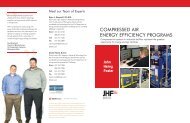The Turbo Air® 3000 Centrifugal Compressor Compressor Handbook
The Turbo Air® 3000 Centrifugal Compressor Compressor Handbook
The Turbo Air® 3000 Centrifugal Compressor Compressor Handbook
Create successful ePaper yourself
Turn your PDF publications into a flip-book with our unique Google optimized e-Paper software.
<strong>The</strong> <strong>Turbo</strong> Air <strong>3000</strong> <strong>Centrifugal</strong> <strong>Compressor</strong> Operator’s Manual<br />
3. When necessary, it is possible to clean the primary filter (which has the screen across its face) in<br />
either of these two ways:<br />
5—8<br />
· Blow 30 psi (2kg/cm 2 or bar) of air from the clean side.<br />
— or —<br />
· Soak and periodically agitate the filter in hot water containing a non-volatile cleaning<br />
agent and then air dry the filter completely before installation.<br />
4. If after cleaning or replacing the primary air filter the air pressure drop returns to normal, that is<br />
an indication that the secondary filters are still clean. However, if the air pressure drop remains<br />
high with the clean or replacement primary filter, it is time to replace the secondary filters.<br />
CAUTION:<br />
Do not operate the compressor for more than 2 minutes without the primary filter. Operation<br />
without proper filtration may cause compressor damage or malfunction.<br />
Bypass Valve Filter Element Replacement<br />
On compressors so equipped, a filter is located in the pilot supply line to the bypass valve. It serves to<br />
prevent water and/or other contaminants from entering the bypass valve’s control mechanism. Use a<br />
Cooper <strong>Turbo</strong>compressor replacement filter only.<br />
<strong>The</strong> replacement procedure is as follows:<br />
1. Completely shut down the compressor and exhaust any pressure in the bypass valve air supply line<br />
and filter.<br />
2. Unscrew the canister that houses the filter from the base.<br />
3. Remove the retaining nut that holds the filter element in place.<br />
4. Inspect the canister o-ring seal; if damaged, replace it at this time.<br />
5. Install the replacement filter element.<br />
6. Replace the retaining nut (being careful not to over-tighten it) and then screw on the filter canister.



